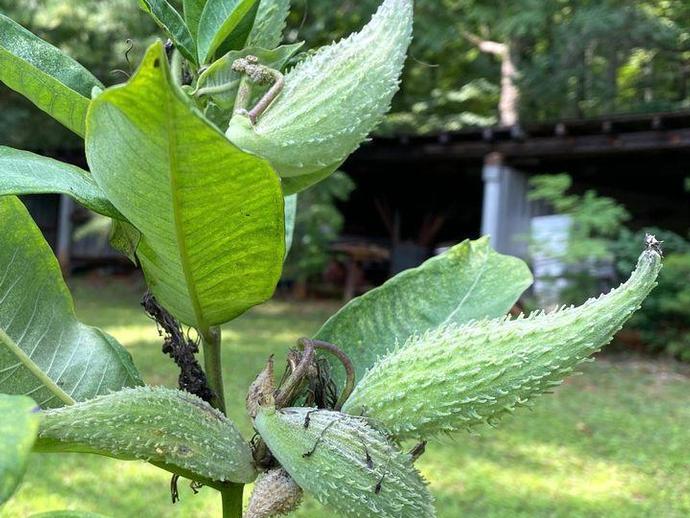August 4, 2021
It's time for another edition of #BenInNature presented by our friends at Carter Bank & Trust!
We've talked in the past about milkweed (genus Asclepias), the perennial flowering plants that are a food source for monarch butterflies (Danaus plexippus) and a nectar source for many different bees and wasps. Today, let's take a look at milkweed pods, the fruits of the milkweed plant that sort of resemble weird little cucumbers!
These are young milkweed pods that have yet to dry out, and they're still full of the milky white latex that gives milkweed its name. This liquid contains cardenolides, which are cardiac glycosides, a type of organic compound that can increase the output force of the heart and increase its rate of contractions. These compounds can be medically useful, but they're obviously not something you want to mess with unless prescribed by a doctor. The white liquid also contains two percent latex, and during World War II, both the United States and Nazi Germany attempted to use milkweed latex as a source of natural rubber; however, neither side was able to attain any kind of large-scale success with these projects.
As milkweed pods dry out, they split open, revealing flat brown seeds with silky fuzz known as "milkweed floss" that allows the seeds to be carried on the wind. The fibers of milkweed floss are hollow and coated in wax, meaning they're both waterproof and buoyant. In another example of creative uses of milkweed during World War II, after the Japanese occupation of Java cut off the U.S. supply of a fluffy plant fiber called kapok, a defense contractor called War Hemp Industries enlisted American schoolchildren to gather milkweed pods at 15 cents per bushel. The milkweed floss they collected was used as a replacement for kapok in live vests!
While life vests are now made with synthetic fibers, milkweed floss is still used in some applications. When combined with goose down, it's an excellent stuffing for jackets, comforters, and pillows!
Milkweed may be toxic, but there are a large number of critters that have evolved to eat milkweed without issue. We'll look at one of them tomorrow!
ABOUT #BenInNature
Social distancing can be difficult, but it presents a great opportunity to become reacquainted with nature. In this series of posts, Administrator of Science Ben Williams ventures outdoors to record a snapshot of the unique sights that can be found in the natural world. New updates are posted Monday - Friday, with previous posts highlighted on the weekends. This series of posts is made possible thanks to the support of VMNH Corporate Partner Carter Bank & Trust (www.cbtcares.com).
NATURE PHOTO IDENTIFICATIONS
If you discover something in nature that you would like help identifying, be sure to message us right here on Facebook with a picture (please include location and date of picture) and we'll have our experts help you identify it!

 Hours & Admissions
Hours & Admissions Directions
Directions

